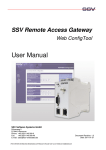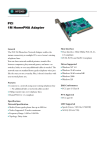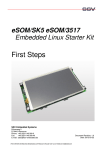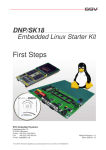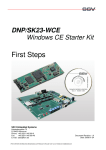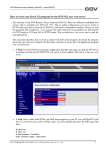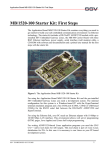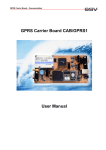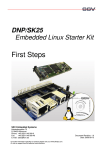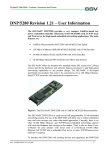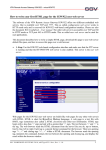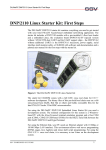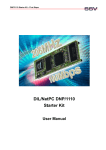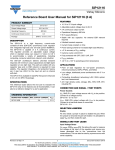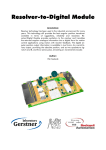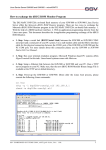Download First Steps IGW/922 - SSV Software Systems
Transcript
Remote Access Gateway IGW/922 with DIL/NetPC ADNP/9200 First Steps SSV Embedded Systems Dünenweg 5 D-30419 Hannover Phone: +49 (0)511/40 000-0 Fax: +49 (0)511/40 000-40 E-mail: [email protected] For further information regarding our products please visit us at www.dilnetpc.com Document Revision: 1.1 Date: 2012-04-12 Remote Access Gateway IGW/922 - First Steps CONTENT 1 INTRODUCTION ...............................................................................................................3 1.1 Checklist ................................................................................................................................3 1.2 Usage .....................................................................................................................................3 1.3 Conventions ...........................................................................................................................3 2 SAFETY GUIDELINES......................................................................................................4 3 HARD- AND SOFTWARE REQUIREMENTS ...................................................................5 4 CONNECTIONS ................................................................................................................6 4.1 RS232 Serial Link..................................................................................................................6 4.2 Ethernet Link .........................................................................................................................7 4.3 Power Supply.........................................................................................................................8 5 OPERATION .....................................................................................................................9 5.1 Serial Connection...................................................................................................................9 5.2 Booting the Embedded Linux..............................................................................................11 5.3 Testing the TCP/IP Communication....................................................................................13 5.4 Accessing the Web ConfigTool...........................................................................................15 5.5 Access via Telnet .................................................................................................................16 5.6 Changing the IP Address .....................................................................................................17 6 INFORMATION IN THE INTERNET................................................................................18 7 MAINTENANCE ..............................................................................................................19 8 DISPOSAL ......................................................................................................................19 9 TROUBLE SHOOTING ...................................................................................................19 10 TECHNICAL DATA..........................................................................................................20 11 EMC INFORMATION ......................................................................................................20 12 PINOUT SCREW TERMINALS .......................................................................................21 13 HELPFUL LITERATURE .................................................................................................22 CONTACT..............................................................................................................................22 DOCUMENT HISTORY .........................................................................................................22 2 SSV EMBEDDED SYSTEMS Remote Access Gateway IGW/922 - First Steps 1 INTRODUCTION With the Remote Access Gateway IGW/922 with DIL/NetPC ADNP/9200 you bought a system, which introduces you in the various types of use of a Linux-based 32-bit embedded system. This documentation gives you an overview about the initial operation and the first steps of use with your new Remote Access Gateway IGW/922. For further information regarding the Remote Access Gateway IGW/922 please visit us at www.ssv-comm.de. 1.1 Checklist Compare the content of your Remote Access Gateway start-up package with the checklist below. If any item is missing or appears to be damaged, please contact SSV. Remote Access Gateway IGW/922 with DIL/NetPC ADNP/9200 Documentation CD-ROM Adapter cable with power and RS232 connector Null modem cable Plug-in power supply Screwdriver Note: For operation you will need a 12 – 24 VDC DIN-rail power supply and at least one Ethernet cross-over cable or two Ethernet patch cables and a switch! 1.2 Usage On the one hand this Remote Access Gateway is suitable to go the first steps in the field of home automation. On the other hand it can be used also for full industrial and process automation applications. Because of the usage of our popular DIL/NetPC as basis, the Remote Access Gateway IGW/922 offers – besides the formidable features of performance – an extraordinary high modularity (QIL-128 form factor). 1.3 Conventions Convention bold italic monospace Usage Important terms Filenames, user inputs Pathnames, program code, command lines Table 1: Conventions used in this document SSV EMBEDDED SYSTEMS 3 Remote Access Gateway IGW/922 - First Steps 2 SAFETY GUIDELINES Please read the following safety guidelines carefully! In case of property or personal damage by not paying attention to this manual and/or by incorrect handling, we do not assume liability. In such cases any warranty claim expires. 4 • To provide the Remote Access Gateway with power an external DIN-rail power supply is needed. The power supply should be in immediate proximity to the Remote Access Gateway. • The power supply must provide a stable output voltage between 12 - 24 VDC. The output power should be at least 2.5 W. • Please pay attention that the power cord or other cables are not squeezed or damaged in any way when you set up the Remote Access Gateway. • The installation of the Remote Access Gateway should be done only by qualified personnel. • Discharge yourself electrostatic before you work with the Remote Access Gateway, e.g. by touching a heater of metal, to avoid damages. • Stay grounded while working with the Remote Access Gateway to avoid damage through electrostatic discharge. • The case of the Remote Access Gateway should be opened only by qualified personnel. SSV EMBEDDED SYSTEMS Remote Access Gateway IGW/922 - First Steps 3 HARD- AND SOFTWARE REQUIREMENTS To work with the Remote Access Gateway IGW/922 a software development environment is needed. This development environment requires a computer as development system to access the Remote Access Gateway via serial console or Telnet. Therefore usually a PC with Intel Pentium or AMD processor under Windows or Linux is used. This PC should comply with the following hard- and software requirements: • Windows 2000/XP/7 or Linux • Serial (COM) interface • Terminal program (HyperTerminal or Minicom) • 10/100 Mbps Ethernet network controller and TCP/IP configuration • Web browser • Telnet client • CD-ROM drive Please check which IP address your PC actual has. Keep this address in mind. On a Linux-PC just open a shell console and enter ifconfig. On a Windows-PC please open a DOS window (you can find it in the Windows Start menu) and enter: ipconfig. Now the IP address is displayed in the DOS window. Note: With a Linux-PC as development system it is possible to develop programs in all languages for the IGW/922. Linux is especially for programming in C/C++ as PC operating system required because of the GNU cross tools. With a Windows-PC the shell-script programming as well as the HTML- and Java-applet programming of the Web server is possible. SSV EMBEDDED SYSTEMS 5 Remote Access Gateway IGW/922 - First Steps 4 CONNECTIONS For a quick and easy start with the Remote Access Gateway IGW/922 there are several connections necessary. The following chapters describe how these connections between the development system (host PC) and the IGW/922 have to be made. 4.1 RS232 Serial Link For a basic communication with the IGW/922 use the null modem cable and connect the COM1 port of the IGW/922 with the COM port of your host PC. Figure 1: RS232 link on serial port COM1 6 SSV EMBEDDED SYSTEMS Remote Access Gateway IGW/922 - First Steps 4.2 Ethernet Link The Ethernet link can be made on two ways: with an Ethernet cross-over cable or with two standard Ethernet patch cables and a hub or switch. In both cases an Ethernet LAN interface for your host PC is required. When using a hub or switch please connect it between the host PC and the IGW/922 like shown fig. 3. Figure 2: Ethernet link with cross-over cable Figure 3: Ethernet link with hub or switch Note: For the Ethernet connection in fig. 2 it is absolutely required to use a cross-over cable. Do not use an ordinary patch cable. Ethernet patch and cross-over cables are in most cases visual indistinguishable. But the internal wiring is fully different. Mixing up these types of cables leads to LAN errors. Hence pay attention to the label of the cable or packing. SSV EMBEDDED SYSTEMS 7 Remote Access Gateway IGW/922 - First Steps 4.3 Power Supply The Remote Access Gateway IGW/922 needs a supply voltage of 11 .. 28 VDC to work. Use the power adapter cable to provide the system with the necessary power like shown in the figure below. Figure 4: Power supply for the Remote Access Gateway IGW/922 Terminal A3 A4 Signal Vin (11 .. 28 VDC) GNDin Table 2: Screw terminal power CAUTION: Providing the Remote Access Gateway IGW/922 with a higher voltage than the regular 11 .. 28 VDC could cause damaged device components! 8 SSV EMBEDDED SYSTEMS Remote Access Gateway IGW/922 - First Steps 5 OPERATION 5.1 Serial Connection To make communication possible between the IGW/922 and the development system a terminal program is needed. Under Windows it is normally HyperTerminal, for Linux exists Minicom, an equivalent program. In the following we use HyperTerminal, but all settings can be made similarly with other terminal programs. If there is no terminal program installed on your development system (this could be the case for a Linux-based PC), you have to install it manually from your operating systems installation CD-ROM. First open a new HyperTerminal session and enter a name for it (e.g. IGW/922). Choose now under „File->Properties“ under „Connect via“ the entry „direct link cable connection via COM1“ (or the COM-port you used). In the next step click on the button „configure“ to get to the next dialog box. Figure 5: Interface dialog box SSV EMBEDDED SYSTEMS 9 Remote Access Gateway IGW/922 - First Steps Now change the settings to the parameters shown in fig. 6 and close the dialog box with a click on „OK“. Figure 6: Communication parameter settings These settings can also be made in other terminal programs. Important are the following parameters and values: Parameter Connection speed Data bits Parity Stop bits Handshake Wert 115.200 bps 8 None 1 None Table 3: Terminal program settings Note: Do not forget to save the session settings with the connection parameters under the name you have chosen (e.g. IGW/922). With this name you can start the terminal program for future IGW/922-access. 10 SSV EMBEDDED SYSTEMS Remote Access Gateway IGW/922 - First Steps 5.2 Booting the Embedded Linux Now you may power up the IGW/922. The boot process starts immediately. The IGW/922 boots thereby an embedded Linux out of its Flash memory. The following figure shows the corresponding messages during this procedure with the Windows terminal program HyperTerminal. Figure 7: Embedded Linux boot process The Linux boot process of the IGW/922 ends with the following command prompt: Figure 8: Linux command prompt SSV EMBEDDED SYSTEMS 11 Remote Access Gateway IGW/922 - First Steps The command prompt is a part of the serial console of the DIL/NetPC ADNP/9200 within the IGW/922. To login enter root as username and root as password. You can now enter any Linux commands, which will be executed by the DIL/NetPC operating system. Command cat cd chmod cp ls mkdir mv ps pwd rm rmdir Function Show file content or write input in file Change directory Change access right for a file Copy file List directory- and filenames, access rights, etc. Make new directory Move file Overview of active processes Show name of actual directory Remove file Remove empty directory Table 4: Some important DIL/NetPC Linux commands Please note that every Linux command must be confirmed with a carriage return. Some commands need additional parameters. Figure 9: Executing Linux commands with a serial console Note: The same DIL/NetPC Linux commands are also executable within the scope of a Telnet session. You will find more details in chapter 5.5 in this manual. 12 SSV EMBEDDED SYSTEMS Remote Access Gateway IGW/922 - First Steps 5.3 Testing the TCP/IP Communication To test the Ethernet connection on the basis of TCP/IP-protocols between the IGW/922 and the host PC we use the very popular TCP/IP-utility program ping. Please open a DOS window on your host PC (you can find it in the Windows Start menu) and enter: ping 192.168.0.126 Directly after this command test data is send from the host PC to the IGW/922 via Ethernet LAN. The IGW/922 must answer on the same way within a certain period of time. Fig. 10 shows the entry of the command as well as the successful execution. In case of an error ping reports a timeout. Figure 10: Communication check via ping The IGW/922 must answer every ping. Otherwise an error will occur. In this case you have to check all parts of your LAN connection, including the IP address of the host PC. The value of the IP address should be 192.168.0.1. For an easy check of the IP address within the DOS window, you can use the following DOS command: ipconfig The fig. 11 shows the ipconfig-messages of a Windows-XP-PC. Note: We assume at this point that the IGW/922 has the ex factory IP address 192.168.0.126. If you have changed this address, you must regard this for the ping parameter. SSV EMBEDDED SYSTEMS 13 Remote Access Gateway IGW/922 - First Steps Figure 11: Communication check via ipconfig command Once the ping was successful, you are ready to start a web browser (e.g. Internet Explorer or Konqueror). 14 SSV EMBEDDED SYSTEMS Remote Access Gateway IGW/922 - First Steps 5.4 Accessing the Web ConfigTool To open the login page of the SSV Web ConfigTool enter this URL in a Web browser: http://192.168.0.126:7777. The following passwords can be used to login: • The default Web ConfigTool password is adnp. This is the standard user and has an idle timeout. The password and the timeout can be changed in the menu over “System > Administration”. • The default Web ConfigTool master password is ssvadmin. This is the master user and has no idle timeout. The password can be changed in the menu over “System > Administration”. Figure 12: Login page of the SSV Web ConfigTool Please note: If a standard user is already logged in, he will be automatically logged out when the master user logs in. In contrast to the standard user it is possible to log in more then once at the same time with the master password. Although it is possible it is not recommended! SSV EMBEDDED SYSTEMS 15 Remote Access Gateway IGW/922 - First Steps 5.5 Access via Telnet To access the IGW/922 with a Telnet client please open a DOS window on your host PC (you can find it in the Windows Start menu) and enter the following command to activate a Telnet session: telnet 192.168.0.126 The Linux of the IGW/922 is configured in a way, which you have to login with the username root and the password root. Figure 13: Starting the Telnet client In the upcoming Telnet window you can enter any Linux commands, which will be executed by the IGW/922 operating system (similar to the serial console). Figure 14: Access via Telnet client Note: The Telnet command in fig. 13 requires the current IP address of the IGW/922 as parameter. 16 SSV EMBEDDED SYSTEMS Remote Access Gateway IGW/922 - First Steps 5.6 Changing the IP Address To change the IP address of the Remote Access Gateway enter the Web ConfigTool and choose from the menu “Network > LAN”. In this section you can configure the LAN settings. Figure 15: LAN settings • Enable/Disable interface LAN: Enable or disable interface LAN. • Obtain an IP address automatically: Device configuration through DHCP server. • Use the following IP address: Manual device configuration. • IP address: IP address of the device. • Subnet mask: Subnet mask of the local network. • Enable/Disable alias IP address: Enable or disable the alias IP address. • Alias IP address: Secondary static IP address for the same interface. • Alias subnet mask: Subnet mask of the alias network. For more detailed information about the Web ConfigTool please read the “SSV Web ConfigTool user manual”. SSV EMBEDDED SYSTEMS 17 Remote Access Gateway IGW/922 - First Steps 6 INFORMATION IN THE INTERNET To fulfil the information needs of the users, we offer the website http://www.ssv-comm.de Visit this website from time to time to access latest information. Figure 16: www.ssv-comm.de On this website are also newer versions of this manual published. Please note therefore the revision number on the last page. 18 SSV EMBEDDED SYSTEMS Remote Access Gateway IGW/922 - First Steps 7 MAINTENANCE A special maintenance for the IGW/922 is not necessary. For technical questions please send an e-mail to [email protected]. 8 DISPOSAL A special disposal of the IGW/922 beyond the regulation by law is not necessary. For questions please send an e-mail to sales@ ssv-embedded.de. 9 TROUBLE SHOOTING If you experience troubles with the IGW/922 please proceed as follows: Check all cable connections carefully. Create a serial RS232-connection – like described in chapter 4.1 – with your development system and try to access the IGW/922 with a terminal program. Reset if necessary the IGW/922 by interrupting the power supply for a moment. Afterwards the IGW/922 should execute a new boot process, which you can watch with the terminal program. If you still have troubles, please send an e-mail to support@ ssv-embedded.de. SSV EMBEDDED SYSTEMS 19 Remote Access Gateway IGW/922 - First Steps 10 TECHNICAL DATA Supply voltage ................................................................................11 – 28 VDC Weight ................................................................................................... < 0,5 kg Mechanical Dimensions (LxWxH) ........................... 112 mm x 45 mm x 100 mm Temperature range .......................................................................... 0° C – 70° C Rel. air himudity.................................................................................max. 85 % 11 EMC INFORMATION The IGW/922 meets following EU directives about electromagnetic compatibility (EMC): Emitted interference Radio disturbance EN 55022 (industrial environment) Interference immunity Case Radiated RF immunity Electrostatic Discharge (ESD) Signal connections Conducted RF immunity Electrical fast transients/bursts Direct current input and output Conducted RF immunity Electrical fast transients/bursts EN 61000-4-3 EN 61000-4-2 EN 61000-4-6 EN 61000-4-4 EN 61000-4-6 EN 61000-4-4 Table 5: EMC information Note: Please do not connect cables longer than 3 meters with the screw terminals. 20 SSV EMBEDDED SYSTEMS Remote Access Gateway IGW/922 - First Steps 12 PINOUT SCREW TERMINALS The table 7 shows the pinout of the screw terminals of the IGW/922. Pin Power COM2 RS232 Alarm RS485* A1 Alarm - A2 Alarm + A3 V+ IN A4 GND IN B1 B2 TXD RX/TX - B3 RXD RX/TX + B4 GND GND Table 6: Pinout of the screw terminals * Please note: The RS485 (officially called TIA/EIA-485-A) connection between your IGW/922 and the field devices needs termination resistors on both ends for proper operation. The IGW/922 does not offer internal termination resistors. Please make sure, that the RS485 cable connection is equipped with external termination resistors. SSV EMBEDDED SYSTEMS 21 Remote Access Gateway IGW/922 - First Steps 13 HELPFUL LITERATURE • IGW/922 hardware reference manual • DIL/NetPC ADNP/9200 hardware reference manual • SSV Web ConfigTool user manual CONTACT SSV Embedded Systems Dünenweg 5 D-30419 Hannover Phone: +49 (0)511/40 000-0 Fax: +49 (0)511/40 000-40 E-mail: [email protected] Internet: www.ssv-comm.de Forum: www.ssv-comm.de/forum DOCUMENT HISTORY Revision 1.0 1.1 Datum 2011-03-14 2012-04-12 Bemerkungen First version Edited the warning in chapter 4.3, edited table 3 Name WBU WBU The content of this document can change any time without announcement. There is taken over no guarantee for the accuracy of the statements. The user assumes the entire risk as to the accuracy and the use of this document. Information in this document is provided ‘as is’ without warranty of any kind. Some names within this document can be trademarks of their respective holders. © 2011 SSV EMBEDDED SYSTEMS. All rights reserved. 22 SSV EMBEDDED SYSTEMS






















